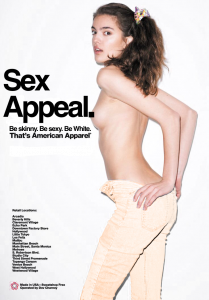ORIGINAL AD

The ad used for my culture jam assignment comes from American Apparel, a clothing brand infamous for its over-sexualized campaigns. The purpose of this ad is to market their jeans to female consumers. However, attention to the product is redirected towards the female model who is seen topless and flaunting her body. This has serious implications concerning gender and race.
The philosophy that underpins this ad is that “sex sells.” This is problematic as American Apparel sexually commodifies their products to reach a targeted demographic of adolescent females. Among the other provocative American Apparel ads, this example illustrates the ideals of fair-skinned, slender, and scantily dressed models. Furthermore, American Apparel often creates ads that mimic candid or intimate moments to generate a false sense of attainable aspirations. This operates in tandem to the ad’s overt contradiction between marketing clothes and having the model remove them. In turn, when consumers view this ad, the focus is less on the product and more on the symbolic values and ideas of the brand. This leads consumers to believe that dressing more revealing and exposing themselves will make them more attractive. However, by creating these sorts of ad, American Apparel is suggesting that purchasing and wearing their products will enable consumers to acquire the same feelings of sex appeal.
American Apparel evokes insecurities of which they exploit to sell their products. The false sense of attainable aspirations is extremely damaging to one’s self-concept and body image. For instance, ads for men’s clothing place fully dressed models in more natural and mundane settings while ads for women’s clothing place half-nude models in sexually contrived scenarios. Such ads insinuate gender roles that demean and delimit women in their achievements and endeavours by subverting their identities to objects of sex. For people of colour, the prominence of fair-skinned models furthers the reach of “attainable aspirations” through underrepresentation. Consumers who do not identify with the ideals of American Apparel are susceptible to devaluing their natural appearance. This can perpetuate hegemonic gender roles and ideals of beauty that are damaging to all women.
JAMMED AD

In my jammed version of the ad, I make several adjustments to accentuate the sexually contrived imagery surrounding American Apparel’s marketing campaigns. I first began by swapping the “Jeans” text to “Sex Appeal” and then creating an additional line telling consumers to be skinny, sexy, and White. I also changed the colour of the jeans to resemble the skin tone of the model. Although these adjustments are minor, the simplicity of my culture jam is deliberate. By making minimal adjustments, I aim to illustrate how easy it is for consumers to be disillusioned by the marketing strategy that “sex sells.” Boldening the “Sex Appeal” and creating the additional line were adjustments purposed for addressing how American Apparel exploits its consumers’ insecurities. In my culture jam, I assert the ideals that American Apparel projects onto their products and consumers. Seemingly, this involves having sex appeal by being slender, more revealing, and fair-skinned. This is an explicit reminder of the imagery that American Apparel relies on to sell its products. Without it, American Apparel is not very different from other companies that also sell plain blue jeans. Changing the colour of the jeans serves as the final driving point of my culture jam. In line with the message of “Sex Appeal,” the matching skin-tone jeans were meant to give the impression that the model was nude. When consumers view the original ad at first glance, they may be indifferent due to the normalization of sexual commodification. However, as they process the image, they will most likely come back to verify whether the model was nude, thus, diverting their attention from the product to the model. Changing the colour of the jeans was intended to illustrate the susceptibility of consumers focusing more on the sexualized elements of the original ad. By exacerbating the issues and negative connotations of the original ad, my culture jam aims to raise awareness of how this form of marketing is damaging to the body image and sense of self of all women, especially those of colour.